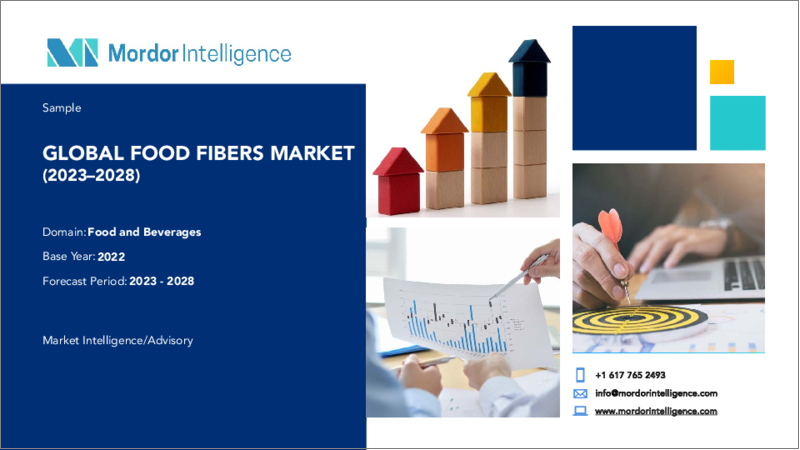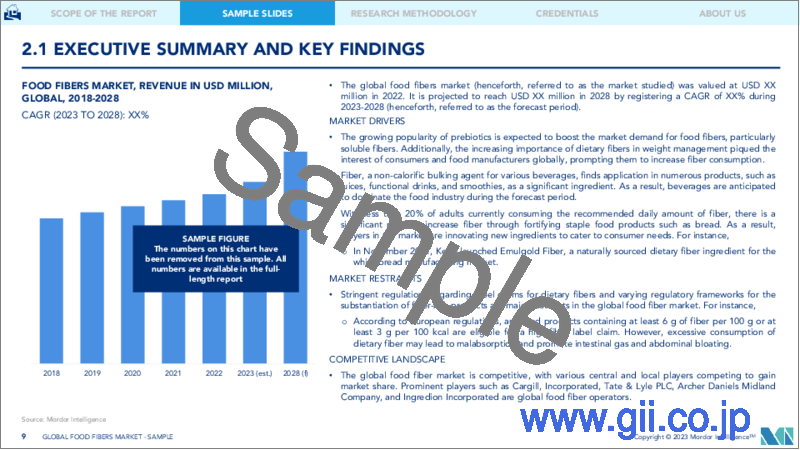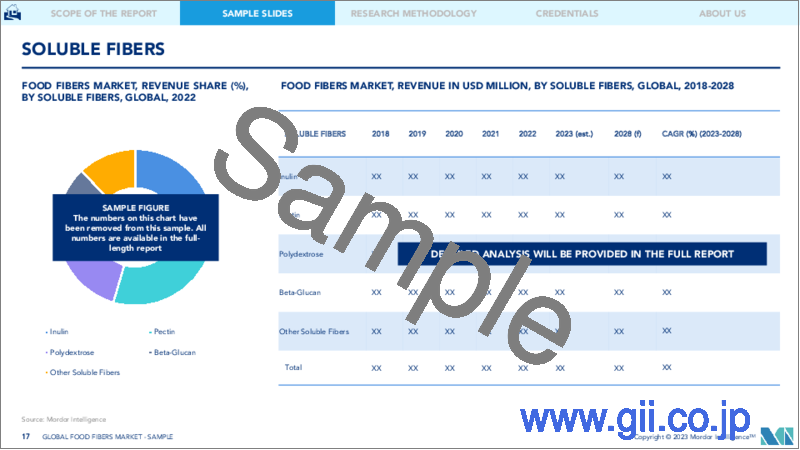|
|
市場調査レポート
商品コード
1190923
食物繊維市場- 成長、動向、予測(2023年~2028年)Food Fibers Market - Growth, Trends, and Forecasts (2023 - 2028) |
||||||
|
● お客様のご希望に応じて、既存データの加工や未掲載情報(例:国別セグメント)の追加などの対応が可能です。 詳細はお問い合わせください。 |
|||||||
| 食物繊維市場- 成長、動向、予測(2023年~2028年) |
|
出版日: 2023年01月18日
発行: Mordor Intelligence
ページ情報: 英文 130 Pages
納期: 2~3営業日
|
- 全表示
- 概要
- 目次
世界の食物繊維市場は、今後5年間に9.15%のCAGRで推移すると予測されています。
ここ数年の間に、消費者による栄養的に重要な食品の需要が増加しています。健康に食物繊維の利点についての意識は、過去数年間でより普及しているので、食物繊維の消費量も大幅に増加しました。健康意識の高い消費者は、健康な腸内細菌叢と免疫機能、代謝の健康、消化器の健康、および精神的な幸福との間の意識の高まりにより、健康のために積極的かつ予防的な措置を取っているのです。食物繊維は、マイクロバイオームをサポートする機能性成分です。
したがって、国際食品情報評議会(IFIC)の2021年食品と健康調査によると、56%以上の消費者が食事に食物繊維の含有量を追加または増加させています。ほとんどの消費者(92%)が食物繊維を食品から摂取しようとする一方で、5人に1人は依然として食物繊維のサプリメントで食事を補っています。さらに、食物繊維産業の成長は、モンクフルーツ抽出物、ステビア、保存可能なバー、シリアル、チップ、プレッツェル、その他のスナックなどの天然代替甘味料などの保存可能な食品に強化することによって増強されます。さらに、タンパク質補助食品や食事代替オプションは、ナッツ、種子、チコリ根などの多様なソースから食物繊維を組み込んでいます。
主な市場動向
食品業界における食物繊維強化の動向の増加
食物繊維は、体重管理、心臓の健康、免疫、満腹感、消化器系の健康など、健康に良いことが証明されており、世界の半数以上の消費者が食物繊維の摂取量を増やそうとしています。このため、メーカーは、クリスプ、パフ、フレークなどの高価値の製品に食物繊維を強化するようになりました。さらに、世界保健機関は、成人女性で25g/日、成人男性で38g/日の食物繊維の摂取を推奨しています。しかし、世界的に見ると、平均して20g/日を下回っているのが現状です。さらに、カリフォルニア大学サンフランシスコ校健康学部の最新の研究によると、米国の成人による食物繊維の平均摂取量は1日約15gだそうです。これは、1日の推奨摂取量の半分に相当します。このギャップは、健康とウェルネスに対する消費者の関心の高まりと相まって、食品業界における食物繊維強化の動向を引き起こしました。
2021年9月、英国食品飲料連盟(FDF)は、国民の食物繊維消費を促進するための新たな取り組みを開始しました。現在、成人のわずか9%が推奨される食物繊維の摂取量を得ているに過ぎません。ネスレ、バーズアイ、ケロッグなど複数の食品ブランドがこの「Action on Fiber」イニシアティブを支持し、製品パッケージで食物繊維の多い選択肢を強調したり、食物繊維を多く含む新製品を発売することを約束したりといった誓約を掲げています。過去数年間、食物繊維の需要の増加は、イヌリンのような植物由来のクリーンラベルの食物繊維の世界の取引も後押ししています。
欧州が市場で突出した地位を維持
食物繊維の消費と関連する健康上の利点に関する意識の高まりが、同地域の市場成長を支える主な要因となっています。これにより、伝統的な食品の消費から食物繊維の多い食品への移行が進んでいます。さらに、豆類、オート麦、亜麻仁、オートブランに含まれる水溶性食物繊維は、血中コレステロール値を下げる効果があるため、この地域における水溶性食物繊維の需要も急増しています。2021年7月、水溶性食物繊維の需要が引き続き伸びていることから、カーギルは4500万米ドル(3800万ユーロ)を投資し、欧州のでんぷん、甘味料、食感改良剤のポートフォリオを拡大し、水溶性食物繊維を追加しました。
英国食品基準局(FSA)は、イヌリンを食物繊維として表示することを認可するためにAOAC国際法を採用しました。この最近の進展により、メーカーは英国においてイヌリンとオリゴフルクトースを食物繊維として表示することができるようになりました。これにより、メーカーは成分表示において、食物繊維を豊富に含む、食物繊維を添加した、食物繊維を豊富に含む、といった効能を謳うことができるようになりました。さらに、この地域では、クリーンラベル食品、機能性食品、植物由来および持続可能な食品に関する高い支持があることから、今後数年間、欧州の食品産業において繊維が重要な成分として位置づけられると思われます。
競合情勢
食物繊維市場は競争が激しく、中央および地方の様々なプレーヤーが市場シェアを獲得しようと競い合っています。主なプレーヤーは、小規模企業の買収、新製品の開発、地理的な拡大により流通経路を強化し、市場の拡大を図ろうとしています。企業は市場シェアを拡大するために、主に麻、エンドウ、ジャガイモといった植物由来の繊維の新たな供給源をターゲットとした革新的な新製品の投入に注力しています。Cargill Incorporated、Archer Daniels Midland Company、Kerry Inc.、Ingredion Incorporated、Tate &Lyleが食物繊維市場で事業を展開する主要な企業です。
その他の特典
- エクセル形式の市場予測(ME)シート
- アナリストによる3ヶ月間のサポート
目次
第1章 イントロダクション
- 調査フェーズと調査の成果
- 調査範囲
第2章 調査手法
第3章 エグゼクティブサマリー
第4章 市場力学
- 市場促進要因
- 市場抑制要因
- 産業の魅力- ポーターのファイブフォース分析
- 供給企業の交渉力
- 消費者の交渉力
- 新規参入業者の脅威
- 代替品の脅威
- 競合の度合い
第5章 市場セグメンテーション
- 種類
- 水溶性食物繊維
- イヌリン
- ペクチン
- ポリデキストロース
- ベータグルカン
- その他の水溶性食物繊維
- 不溶性食物繊維
- セルロース
- リグニン
- ヘミセルロース
- キチン・キトサン
- レジスタントスターチ
- その他不溶性繊維
- 水溶性食物繊維
- 用途
- 飲食品
- ベーカリー・菓子類
- 乳製品
- 肉・鶏・魚介類
- 飲料
- その他
- 栄養補助食品
- 医薬品
- 飲食品
- 地域別
- 北米
- 米国
- カナダ
- メキシコ
- その他北米地域
- 欧州
- 英国
- フランス
- ドイツ
- イタリア
- ロシア
- スペイン
- その他欧州
- アジア太平洋地域
- 中国
- 日本
- オーストラリア
- インド
- その他アジア太平洋地域
- 南米
- ブラジル
- アルゼンチン
- その他の南米地域
- 中東・アフリカ地域
- サウジアラビア
- 南アフリカ
- その他中東・アフリカ地域
- 北米
第6章 競合情勢
- キープレイヤーが採用した戦略
- 市場シェア分析
- 企業プロファイル
- Cargill, Incorporated
- Tate & Lyle PLC
- Archer Daniels Midland Company
- Ingredion Incorporated
- Roquette Freres SA
- Kerry Group PLC
- Suddeutsche Zuckerrubenverwertungs-Genossenschaft eG(Beneo Remy NV)
- International Flavors & Fragrances Inc.
- J. Rettenmaier & Sohne GmbH+Co. KG
- Nexira Inc.
第7章 市場機会と今後の動向
The Global Food Fibers Market is projected to register at a CAGR of 9.15% over the next five years.
Over the last couple of years, there has been an increase in the demand for nutritionally significant food by consumers. Since the awareness about the benefits of food fibers on health has become more prevalent over the past few years, the consumption of food fibers has also increased significantly. Health-conscious consumers are taking proactive and preventive measures for their health owing to increased awareness between a healthy gut microbiome and immune function, metabolic wellness, digestive health, and mental well-being. Fiber is a functional ingredient that supports the microbiome.
Thus, according to the 2021 Food and Health Survey from the International Food Information Council (IFIC), over 56% of consumers added or increased fiber content in their diet. While most consumers (92%) seek to get fiber from food, one in five still supplement their diet with fiber supplements. Additionally, the growth of the food fiber industry is augmented by its fortification in shelf-stable food products, such as natural alternative sweeteners, like monk fruit extracts, stevia, shelf-stable bars, cereal, chips, pretzels, and other snacks. Moreover, protein supplements and meal replacement options incorporated dietary fibers from diverse sources, such as nuts, seeds, and chicory root.
Key Market Trends
Increasing Trend of Fiber Fortification in Food Industry
Dietary fibers offer proven health benefits, including weight management, heart health, immunity, satiety, and digestive health, as more than half of consumers worldwide are trying to increase their fiber intake. This prompted manufacturers to fortify higher-value products, like crisps, puffs, flakes, and other dietary fibers. Furthermore, World Health Organization has recommended a fiber intake of 25 g/day for adult women and 38 g/day for adult men. However, globally, the average information is below 20 g/day. Additionally, according to the latest study by the University of California San Francisco Health, the average fiber intake by adults in United States is around 15 grams daily. This represents half the recommended daily amount. This gap, coupled with increased consumer attention toward health and wellness, has triggered the fiber fortification trend in the food industry.
In September 2021, United Kingdom Food and Drink Federation (FDF) launched a new initiative to boost the nation's fiber consumption. Currently, only 9% of adults are getting recommended fiber intake. Several food brands, including Nestle, BirdsEye, and Kellogs, have supported this 'Action on Fiber' initiative and have undertaken pledges such as highlighting higher fiber options on product packaging to commitments to launch new products containing high amounts of fiber. In the past few years, the increased fiber demand has also been boosting the global trade of plant-based, clean-label fibers such as inulin.
Europe Remains Prominent in the Market
The increasing awareness regarding the consumption of food fibers and the associated health benefits are the main factors supporting the growth of the market in the region. This has increased the transition from consuming traditional foods to high-fiber foods. Additionally, the demand for soluble fiber in this region has also soared, as soluble fiber found in beans, oats, flaxseed, and oat bran may help lower blood cholesterol levels. In July 2021, due to the continued growth in demand for soluble fibers, Cargill invested USD 45 million (EUR 38 million) in the expansion of its European portfolio of starches, sweeteners, and texturizers to include soluble fibers.
The United Kingdom Food Standards Agency (FSA) has adopted an AOAC international method to authorize the labeling of inulin as a fiber. This recent development allows manufacturers to label inulin and oligofructose as dietary fibers in United Kingdom. Manufacturers now claim the following benefits on the ingredient label - enriched with fiber, fibers added, and rich in fiber. Moreover, high traction around clean-label food, functional food products, and plant-based and sustainable food products in the region will also likely make fibers a key ingredient in the European food industry in the coming years.
Competitive Landscape
The food fiber market is competitive, with various central and local players competing to gain market share. Key players are trying to expand their market by strengthening their distribution channels by acquiring small companies, developing new products, and expanding their geographical presence. Companies focus on introducing new innovative products to increase their market share, primarily by targeting new sources of plant-based fiber, such as hemp, pea, and potato. Cargill Incorporated, Archer Daniels Midland Company, Kerry Inc., Ingredion Incorporated, and Tate & Lyle are the major players operating in the food fiber market.
Additional Benefits:
- The market estimate (ME) sheet in Excel format
- 3 months of analyst support
TABLE OF CONTENTS
1 INTRODUCTION
- 1.1 Research Phases & Study Deliverables
- 1.2 Scope of the Study
2 RESEARCH METHODOLOGY
3 EXECUTIVE SUMMARY
4 MARKET DYNAMICS
- 4.1 Market Drivers
- 4.2 Market Restraints
- 4.3 Industry Attractiveness - Porter's Five Forces Analysis
- 4.3.1 Bargaining Power of Suppliers
- 4.3.2 Bargaining Power of Consumers
- 4.3.3 Threat of New Entrants
- 4.3.4 Threat of Substitute Products
- 4.3.5 Degree of Competition
5 MARKET SEGMENTATION
- 5.1 Type
- 5.1.1 Soluble Fibers
- 5.1.1.1 Inulin
- 5.1.1.2 Pectin
- 5.1.1.3 Polydextrose
- 5.1.1.4 Beta-glucan
- 5.1.1.5 Other Soluble Fibers
- 5.1.2 Insoluble Fibers
- 5.1.2.1 Cellulose
- 5.1.2.2 Lignin
- 5.1.2.3 Hemicellulose
- 5.1.2.4 Chitin and Chitosan
- 5.1.2.5 Resistant Starch
- 5.1.2.6 Other Insoluble Fibers
- 5.1.1 Soluble Fibers
- 5.2 Application
- 5.2.1 Food and Beverage
- 5.2.1.1 Bakery and Confectionery
- 5.2.1.2 Dairy
- 5.2.1.3 Meat, Poultry, and Seafood
- 5.2.1.4 Beverages
- 5.2.1.5 Others
- 5.2.2 Dietary Supplements
- 5.2.3 Pharmaceuticals
- 5.2.1 Food and Beverage
- 5.3 Geography
- 5.3.1 North America
- 5.3.1.1 United States
- 5.3.1.2 Canada
- 5.3.1.3 Mexico
- 5.3.1.4 Rest of North America
- 5.3.2 Europe
- 5.3.2.1 United Kingdom
- 5.3.2.2 France
- 5.3.2.3 Germany
- 5.3.2.4 Italy
- 5.3.2.5 Russia
- 5.3.2.6 Spain
- 5.3.2.7 Rest of Europe
- 5.3.3 Asia-Pacific
- 5.3.3.1 China
- 5.3.3.2 Japan
- 5.3.3.3 Australia
- 5.3.3.4 India
- 5.3.3.5 Rest of Asia-Pacific
- 5.3.4 South America
- 5.3.4.1 Brazil
- 5.3.4.2 Argentina
- 5.3.4.3 Rest of South America
- 5.3.5 Middle-East and Africa
- 5.3.5.1 Saudi Arabia
- 5.3.5.2 South Africa
- 5.3.5.3 Rest of Middle-East and Africa
- 5.3.1 North America
6 COMPETITIVE LANDSCAPE
- 6.1 Strategies adopted by Key players
- 6.2 Market Share Analysis
- 6.3 Company Profiles
- 6.3.1 Cargill, Incorporated
- 6.3.2 Tate & Lyle PLC
- 6.3.3 Archer Daniels Midland Company
- 6.3.4 Ingredion Incorporated
- 6.3.5 Roquette Freres SA
- 6.3.6 Kerry Group PLC
- 6.3.7 Suddeutsche Zuckerrubenverwertungs-Genossenschaft eG (Beneo Remy NV)
- 6.3.8 International Flavors & Fragrances Inc.
- 6.3.9 J. Rettenmaier & Sohne GmbH + Co. KG
- 6.3.10 Nexira Inc.




